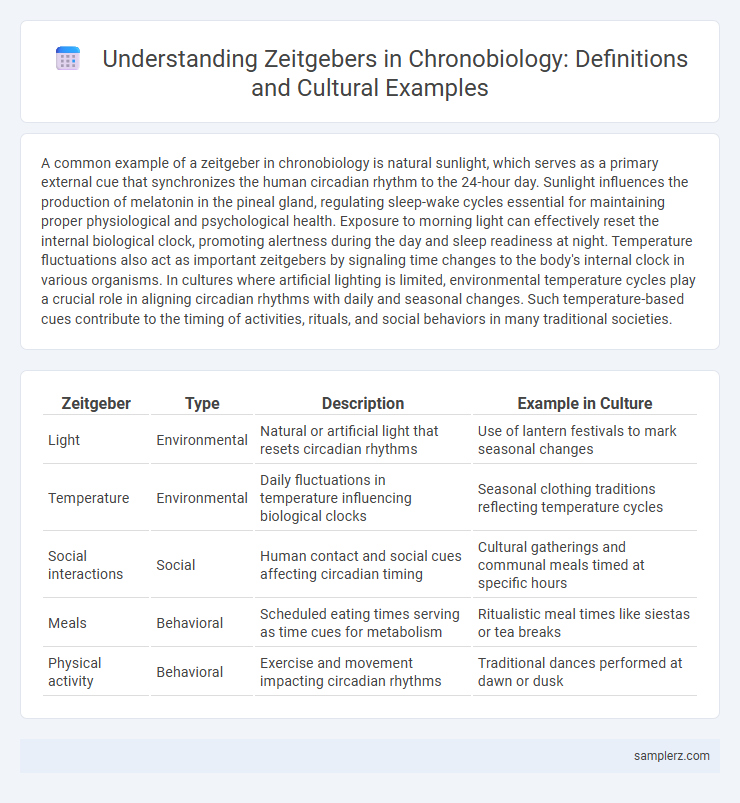A common example of a zeitgeber in chronobiology is natural sunlight, which serves as a primary external cue that synchronizes the human circadian rhythm to the 24-hour day. Sunlight influences the production of melatonin in the pineal gland, regulating sleep-wake cycles essential for maintaining proper physiological and psychological health. Exposure to morning light can effectively reset the internal biological clock, promoting alertness during the day and sleep readiness at night. Temperature fluctuations also act as important zeitgebers by signaling time changes to the body's internal clock in various organisms. In cultures where artificial lighting is limited, environmental temperature cycles play a crucial role in aligning circadian rhythms with daily and seasonal changes. Such temperature-based cues contribute to the timing of activities, rituals, and social behaviors in many traditional societies.
Table of Comparison
| Zeitgeber | Type | Description | Example in Culture |
|---|---|---|---|
| Light | Environmental | Natural or artificial light that resets circadian rhythms | Use of lantern festivals to mark seasonal changes |
| Temperature | Environmental | Daily fluctuations in temperature influencing biological clocks | Seasonal clothing traditions reflecting temperature cycles |
| Social interactions | Social | Human contact and social cues affecting circadian timing | Cultural gatherings and communal meals timed at specific hours |
| Meals | Behavioral | Scheduled eating times serving as time cues for metabolism | Ritualistic meal times like siestas or tea breaks |
| Physical activity | Behavioral | Exercise and movement impacting circadian rhythms | Traditional dances performed at dawn or dusk |
Understanding Zeitgebers: Cultural Insights
Zeitgebers, or external cues like light, temperature, and social activities, regulate biological rhythms by synchronizing internal clocks to the external environment. Cultural practices such as communal meal times, work schedules, and social rituals function as potent zeitgebers, influencing circadian rhythms and sleep-wake cycles. Understanding these cultural zeitgebers reveals how societal norms and traditions shape human chronobiology, highlighting the interplay between environment, behavior, and biological timing.
Key Cultural Zeitgebers in Daily Life
Key cultural zeitgebers include social schedules, meal times, and work routines that synchronize human circadian rhythms with the environment. Regular social interactions and communal activities serve as powerful external cues, influencing sleep-wake cycles and hormonal fluctuations. These cultural timekeepers play a crucial role in maintaining biological rhythms and overall well-being within societies.
Light Exposure as a Universal Zeitgeber
Light exposure serves as the most influential zeitgeber in chronobiology, regulating the human circadian rhythm by signaling the suprachiasmatic nucleus to synchronize sleep-wake cycles. Natural sunlight and artificial lighting patterns help adjust internal clocks, affecting hormone release such as melatonin, which governs alertness and restfulness. Cultural practices like timed work schedules and social activities are often aligned with local light-dark cycles, demonstrating light's universal role in maintaining biological and social rhythms.
Mealtime Traditions and Circadian Rhythms
Mealtime traditions act as powerful zeitgebers in chronobiology by helping to regulate circadian rhythms through consistent timing of food intake. Cultural practices such as communal dinners at sunset or fasting periods like Ramadan influence the body's internal clock by signaling metabolic and hormonal changes aligned with daylight cycles. These social eating patterns synchronize physiological functions, enhancing sleep quality and overall well-being by reinforcing the timing cues within the circadian system.
Religious Practices Shaping Biological Clocks
Religious practices such as prayer times, fasting rituals, and Sabbath observance serve as potent zeitgebers that synchronize individuals' circadian rhythms with spiritual schedules. These culturally embedded time cues influence hormonal secretion and sleep patterns, reinforcing communal biological clocks. The alignment of religious rituals with environmental light-dark cycles exemplifies the interaction between cultural behavior and innate chronobiological processes.
Social Gatherings as Timing Cues
Social gatherings act as powerful zeitgebers that synchronize human circadian rhythms by providing consistent social cues related to meal times, activities, and light exposure. Cultural events such as festivals, communal meals, and work schedules influence sleep-wake cycles and hormonal patterns, aligning biological processes with societal rhythms. This synchronization enhances social cohesion and helps regulate physiological functions through shared temporal structures.
Work Schedules and Chronobiology in Culture
Work schedules act as powerful zeitgebers in chronobiology by influencing circadian rhythms through regular timing of activity and rest periods. Cultural variations in work patterns, such as fixed office hours versus flexible or shift-based schedules, significantly affect individuals' internal biological clocks and overall well-being. Understanding these cultural differences helps optimize work environments to align better with natural circadian processes, enhancing productivity and health.
Festivals and Seasonal Zeitgebers
Festivals serve as powerful seasonal zeitgebers by aligning human activities with environmental rhythms, such as the winter solstice celebrations that mark changes in daylight. Cultural events like harvest festivals synchronize communal behavior with agricultural cycles, reinforcing circadian and circannual rhythms. These social zeitgebers influence sleep patterns, hormone production, and mood by providing temporal cues embedded in cultural practices.
Urbanization and Changing Temporal Cues
Urbanization significantly alters traditional zeitgebers by shifting exposure from natural light-dark cycles to artificial lighting and irregular social schedules, disrupting circadian rhythms. The prevalence of electric lighting reduces melatonin production, affecting sleep patterns and overall health. Changes in work hours, social interactions, and screen time further modify temporal cues that regulate biological clocks in urban populations.
Cultural Adaptations to Chronobiological Rhythms
Cultural adaptations to chronobiological rhythms often involve the integration of zeitgebers such as social schedules, meal times, and artificial lighting to regulate daily biological cycles. In many traditional societies, communal activities and environmental cues like sunrise and sunset act as natural zeitgebers, synchronizing circadian rhythms with cultural practices. Modern urban environments rely heavily on artificial light and structured timekeeping to maintain alignment with endogenous clocks despite irregular natural light exposure.

example of zeitgeber in chronobiology Infographic
 samplerz.com
samplerz.com